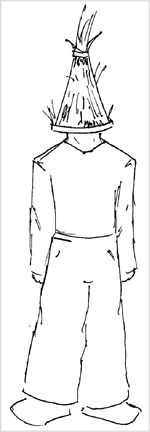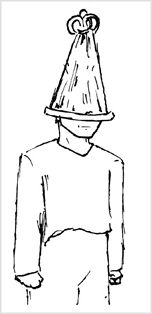Understanding The Straw Boys of Irelands Northwest
Irelands traditional party crashers in strange hats
If you like unusual headgear, you’ll envy the Straw Boys, one of Irelands most eccentric traditions.
Researching the Straw Boys is a little like studying the Loch Ness monster. Everyone who writes about them seems to give a different explanation of who they are, where they came from and what they do.

Whenever they started, the Straw Boys seem to have survived in modern Irish life – at least in the western counties of Ireland where they almost certainly originated. They’re most often described as an exceptionally odd bunch of party crashers – young men who appear suddenly at a wedding, possibly uninvited, and dance with the bride and groom before departing as swiftly as they arrived. The only thing thats consistent in all the stories about them is the way they conceal their identities behind stylized hats made of straw.
Still Dancing
Many present-day accounts say that the Straw Boys still appear at weddings from the Achill Island area (northwest county Mayo) on down through the middle west. They’re familiar enough, in fact, that some wedding planners offer Straw Boys as a feature you can choose, along with champagne and chocolate cake, from the standard event menu. For about $250, you can apparently have a group of 4-5 of these fellows enter the dinner room, accompanied by a fiddle, dance around the tables for a few minutes, and then lift the bride from her chair and carry her out to the dance floor to begin the “Ceili.”
According to Jane Fitzgerald, speaking on a wedding website, “they were boys who rustled cattle. After the job, theyd avoid capture by dressing in straw hats and sneaking into a wedding. Theyd drink and dance but never talk. Eventually they got to be a sign of good luck. Its called strawing a wedding. Another wedding planner advertizes Straw Boys who dance around the bride and groom to protect them from evil spirits. But many traditional accounts say the boys don’t appear at the wedding at all, but at the brides house before the wedding. Several other writers say that in olden days, weddings were usually for family members only, and that the Straw Boys led a delegation of friends into the town square to welcome the bride and groom home from their honeymoon.
Homeless?

Michael MacCarthy Morroghs excellent book, The Irish Century, links the Straw Boys to a different tradition, calling them “Irish equivalents of the many groups of mummers who went around acting out traditional plays and songs at Christmas and other times of the year in England. They expected to be rewarded with food and drink in return for the entertainment they offered.” Film buffs may recall a portrayal of 1950s vintage Irish mummers in 1992s “The Playboys,” starring Aidan Quinn. The history of travelling performers, says Morrogh, may have arisen out of “a tradition of young, well-educated but homeless men looking for hospitality in return for music and song.” A photo in his book portrays a rather jaunty group of Straw Boys, faces concealed by their odd straw hats, visiting an Irish bride before her wedding to play music for her.
Burying the Wren
They seem to be mixed up at times with another group known as the “Wren Boys.” These other “boys” go from house to house on St. Stephens’ day (the day after Christmas) singing songs and collecting money to bury a wren, who has died from a collision with the furze, a yellow bramble bush prevalent in the west. They repeat this poem as they go:
The wren, the wren the king of all birds
St. Stevens day he was caught in the furze
Up with the kettle and down with the pan
Give us some money to bury the wren
The Wren boys, often around 10 years of age, go about with a decorated holly branch, symbolizing the furze. The money they collect supposedly goes to pay for a“Wren Dance” that evening. Its not really clear whether the Straw Boys are part of this ritual as well, though they’re lumped into Christmas celebrations in many books.
If you’re in Sligo or Mayo and you happen to come across a Straw Boy, ask him whats the idea of the blinkin’ hat, and drop us a line with his answer
“The Irish Century,” by Michael MacCarthy Morrogh. 1998 Robert Rinehard Publisher.
Straw Boy illustrations by Nick Werber